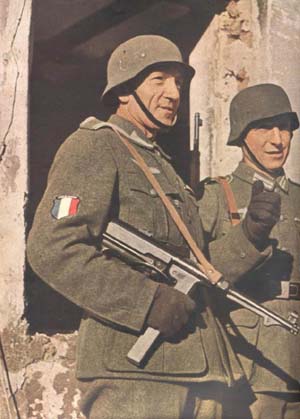
The soldiers noted that the first night in Berlin was unnaturally quiet. They heard people dancing and laughing, but no sounds of fighting were audible except for the occasional distant sound of Soviet artillery.They walked from West to East Berlin, to a brewery near the Hermannplatz. Here the fighting began, with Hitler Youth firing Panzerfausts at Soviet tanks belonging to advance guards near the Tempelhof Aerodrome. Soon some members of the Sturmbataillon joined the Hitler Youth in tank hunting sorties.
Supported by Tiger II tanks and the 11th SS Panzer-Battalion “Hermann von Salza”, the Sturmbataillon took part in a counterattack on the morning of 26 April in Neukölln, a district in southeastern Berlin near the Sonnenallee. The counterattack ran into an ambush by Soviet troops using a captured German Panther tank. The regiment lost half of the available troops in Neukölln on the first day. It later defended Neukölln’s Town Hall.
Given that Neukölln was heavily penetrated by Soviet combat groups, Krukenberg prepared fallback positions for Sector C defenders around Hermannplatz. He moved his headquarters into the opera house. As the Nordland Division withdrew towards Hermannplatz the French SS and one-hundred Hitler Youth attached to their group destroyed 14 Soviet tanks with panzerfausts; one machine gun position by the Halensee bridge managed to hold up any Soviet advance in that area for 48 hours.
There, Krukenberg’s Nordland headquarters was a carriage in the Stadtmitte U-Bahn station. Fighting was very heavy and by 28 April, approximately 108 Soviet tanks had been destroyed in the southeast of Berlin within the S-Bahn. Sixty-two of those were destroyed by the efforts of the Charlemagne Sturmbataillon alone, which was now under the command of SS-Hauptsturmführer Henri Joseph Fenet. Fenet and his battalion were given the area of Neukölln, Belle Alliance Platz, Wilhelmstrasse and the Friedrichstrasse to defend.

Fenet, who was now wounded in the foot, remained with his battalion as they withdrew to the vicinity of the Reich Aviation Ministry in the central government district under the command of SS-Brigadeführer Wilhelm Mohnke. For the success of the battalion during the Battle in Berlin, Mohnke awarded the Knight’s Cross of the Iron Cross to Fenet on 29 April 1945.
On 28 April, the Red Army started a full-scale offensive into the central sector. Fighting was intense, the Sturmbataillon Charlemagne was in the center of the battle zone around the Reich Chancellery. SS-Unterscharführer Eugene Vaulot, who had destroyed two tanks in Neukölln, used his Panzerfausts to claim six more near the Führerbunker. He was awarded the Knight’s Cross of the Iron Cross by Krukenberg during a candlelight ceremony on the Stadtmitte U-Bahn station platform on 29 April. Vaulot did not survive the battle being killed three days later.
The French Charlemagne SS were the last defenders of Hitler’s Führerbunker, remaining there until 2 May to prevent the Soviets from capturing it on May Day.
Reduced to approximately thirty able men, most members of the Sturmbataillon had been captured or escaped Berlin on their own, or in small groups. Most of those who made it to France were denounced and sent to Allied prisons and camps. For example, Fenet was sentenced to 20 years of forced labour, but was released from prison in 1959. Others were shot upon capture by the French authorities. General Philip Leclerc, the French divisional commander who had served under the Americans, was presented with a defiant group of 11-12 captured Charlemagne Division men. The Free French General immediately asked them why they wore a German uniform, to which one of them replied by asking the General why he wore an American one (the Free French wore modified US army uniforms). The group of French Waffen-SS men was later executed without any form of military tribunal procedure.
www.warhistoryonline.com

Δεν υπάρχουν σχόλια:
Δημοσίευση σχολίου